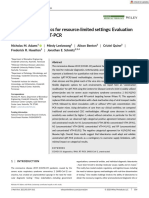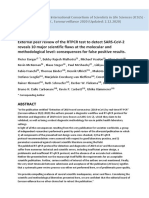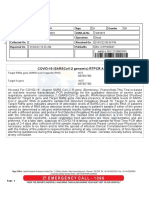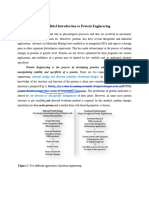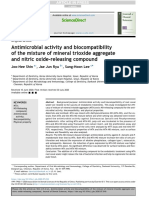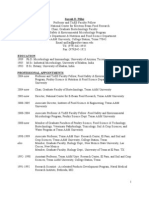Comparison of National RT-PCR Primers, Probes, and Protocols For Sars-Cov-2 Diagnostics
Comparison of National RT-PCR Primers, Probes, and Protocols For Sars-Cov-2 Diagnostics
Uploaded by
Tauseeq HaiderCopyright:
Available Formats
Comparison of National RT-PCR Primers, Probes, and Protocols For Sars-Cov-2 Diagnostics
Comparison of National RT-PCR Primers, Probes, and Protocols For Sars-Cov-2 Diagnostics
Uploaded by
Tauseeq HaiderOriginal Title
Copyright
Available Formats
Share this document
Did you find this document useful?
Is this content inappropriate?
Copyright:
Available Formats
Comparison of National RT-PCR Primers, Probes, and Protocols For Sars-Cov-2 Diagnostics
Comparison of National RT-PCR Primers, Probes, and Protocols For Sars-Cov-2 Diagnostics
Uploaded by
Tauseeq HaiderCopyright:
Available Formats
Comparison of National RT-PCR Primers, Probes,
and Protocols for SARS-CoV-2 Diagnostics April 13, 2020
In this fact sheet, we provide a detailed comparison of several many different protocols for reverse transcriptase polymerase
RT-PCR tests developed by various countries. Our review is chain reaction (RT-PCR) diagnostic testing for SARS-CoV-2,
limited to those listed in the World Health Organization (WHO) the causative agent of COVID-19 disease, they are not all
resource of in-house–developed molecular assays (accessible designed to target the same segments of the genome (see
here) that have been used as the national test of choice in many Figure 1). Many nationally used RT-PCR protocols target the
countries and in regional reference laboratories. Depending on nucleocapsid phosphoprotein (N protein) of SARS-CoV-2. This
the test protocol, various primers, probes, concentrations of is because, among other reasons, it is a highly conserved region
primers and probes, recommended extraction methods, and RT- in coronaviruses and likely to deliver consistent results as the
PCR kits are used. pandemic progresses.
Primers are small fragments of single-stranded DNA designed The N region genome map in Figure 2 below includes primers
to bind specifically to a single region in the genome to allow from 5 institutions that had at least 1 target within the N
for precise amplification of the diagnostic target area. Probes protein. As such, this is not an exhaustive look at all primers in
bind to the target area and give off a fluorescent signal as use for RT-PCR diagnostics of COVID-19; however, it does
amplification of that area increases. This fluorescent signal is illustrate the variability in the primer selection process between
then read by the quantitative real-time PCR machine where the different institutions, even when creating primers for the same
reaction is occurring to give a diagnostic read-out. Molecular genomic region of the same virus.
scientists use many different tools to design the most appropriate
primers to create functional diagnostic targets. While there are
Figure 1. SARS-CoV-2 genome (NC_004718.3). Orf, open reading frame; S, spike gene; E, envelope gene; M, membrane gene; N,
nucleocapsid gene. Gene size drawn to scale.
How to read the N region genome map: How to interpret sensitivity and specificity
• Different colors represent primer sets from different measures in the RT-PCR Master Table
protocols. In the case of the United States, there are 2 In each set of primers described, sensitivity and specificity are
separate primer pairs, all in the same color. included. Sensitivity and specificity measures were not available
• Primer pairs include a forward primer and a reverse primer for all protocols.
in order to read both strands of DNA. Within the same
protocol, the first color-blocked sequence is the forward Sensitivity refers to the level at which the protocol can recognize
primer, the intervening uncolored sequence is the area the presence of SARS-CoV-2 RNA. The higher the sensitivity,
being amplified during PCR, and the second corresponding the less viral RNA is required for a positive test result. Tests
color-blocked sequence is the reverse primer. with high sensitivity have a lower chance of missing a true
• Note: Although SARS-CoV-2 is an RNA virus, positive (ie, declaring a false negative), an important factor
during the RT-PCR process it is reverse-transcribed when testing positive or negative can affect treatment and
into DNA for increased stability and ease of use. hospitalization decisions. Primer sets and probes can be tested
• Mixed colors denote areas of primer overlap between for their sensitivity using a range of fixed concentrations of in
national protocols. For example, the forward primer from vitro transcribed SARS-CoV2- viral RNA transcripts (positive
Thailand’s protocol overlaps slightly with the reverse N1 controls). The limit of detection (LOD) is the lowest possible
primer from the United States protocol. concentration of SARS-CoV-2 that can be detected under the
experimental conditions in at least 95% of all reactions. Most
tests aim for an LOD of 10 RNA copies per reaction. A test with
a low LOD would be considered more sensitive. Having a low
LOD means that the test can detect low-level infections.
© Johns Hopkins Center for Health Security, centerforhealthsecurity.org 04/13/2020
Fact Sheet: Comparison of National RT-PCR Primers, Probes, and Protocols for SARS-CoV-2 Diagnostics 2
Specificity refers to whether the test recognizes only SARS-
CoV-2 RNA and not other closely related pathogens or human
RNA transcripts. Tests with high specificity have a lower chance
of declaring a false positive; rather, tests with high specificity
have a greater ability to rule out true negatives from further
clinical suspicion. Primer and probe specificity can be increased
by ensuring they do not share great sequence similarity with
other viral RNA sequences. Choosing primers and probes that
recognize highly specific genome domains of SARS-CoV-2,
such as the N domain, can help to increase specificity. Most
laboratories have also assessed test specificity by checking
for cross-reactivity with a panel of respiratory viruses, such
as influenza A (H1N1), influenza A (H1N3), influenza B,
rhinovirus, and other human coronaviruses. Ideally, cross-
reactivity should be tested on RNA derived from patient samples.
To be deemed adequately specific, the test should not read
positive for any virus other than SARS-CoV-2.
The master table is not intended to make claims on which test
is better or more reliable than others; more research would be
required to answer those questions. Still, it is important to be
able to understand what parameters the developing institutions
used when validating their protocols.
© Johns Hopkins Center for Health Security, centerforhealthsecurity.org 04/13/2020
Fact Sheet: Comparison of National RT-PCR Primers, Probes, and Protocols for SARS-CoV-2 Diagnostics 3
Note: The beginning and ending nucleotides represented on this page do not represent the actual boundaries of the N protein but were rather arbitrary points chosen
for ease of visibility of the highlighted SARS-CoV-2 primers. The full sequence of the N protein can be accessed here.
GATATCGGTAATTATACAGTTTCCTGTTCACCTTTTACAATTAATTGCCAGGAACCTAAATTGGGTAGTCTTGTAGTGCGTTGTTCGT
TCTATGAAGACTTTTTAGAGTATCATGACGTTCGTGTTGTTTTAGATTTCATCTAAACGAACAAACTAAAATGTCTGATAATGGACCC US, N1
CAAAATCAGCGAAATGCACCCCGCATTACGTTTGGTGGACCCTCAGATTCAACTGGCAGTAACCAGAATGGAGAACGCAGTGGGGC
GCGATCAAAACAACGTCGGCCCCAAGGTTTACCCAATAATACTGCGTCTTGGTTCACCGCTCTCACTCAACATGGCAAGGAAGACCTT
AAATTCCCTCGAGGACAAGGCGTTCCAATTAACACCAATAGCAGTCCAGATGACCAAATTGGCTACTACCGAAGAGCTACCAGACGA
ATTCGTGGTGGTGACGGTAAAATGAAAGATCTCAGTCCAAGATGGTATTTCTACTACCTAGGAACTGGGCCAGAAGCTGGACTTCC
CTATGGTGCTAACAAAGACGGCATCATATGGGTTGCAACTGAGGGAGCCTTGAATACACCAAAAGATCACATTGGCACCCGCAATCC
TGCTAACAATGCTGCAATCGTGCTACAACTTCCTCAAGGAACAACATTGCCAAAAGGCTTCTACGCAGAAGGGAGCAGAGGCGGCA
GTCAAGCCTCTTCTCGTTCCTCATCACGTAGTCGCAACAGTTCAAGAAATTCAACTCCAGGCAGCAGTAGGGGAACTTCTCCTGCTA
GAATGGCTGGCAATGGCGGTGATGCTGCTCTTGCTTTGCTGCTGCTTGACAGATTGAACCAGCTTGAGAGCAAAATGTCTGGTAAA
GGCCAACAACAACAAGGCCAAACTGTCACTAAGAAATCTGCTGCTGAGGCTTCTAAGAAGCCTCGGCAAAAACGTACTGCCACTAAA
GCATACAATGTAACACAAGCTTTTGGCAGACGTGGTCCAGAACAAACCCAAGGAAATTTTGGGGACCAGGAACTAATCAGACAAGG
AACTGATTACAAACATTGGCCGCAAATTGCACAATTTGCCCCCAGCGCTTCAGCGTTCTTCGGAATGTCGCGCATTGGCATGGAAG US, N2
TCACACCTTCGGGAACGTGGTTGACCTACACAGGTGCCATCAAATTGGATGACAAAGATCCAAATTTCAAAGATCAAGTCATTTTGC
TGAATAAGCATATTGACGCATACAAAACATTCCCACCAACAGAGCCTAAAAAGGACAAAAAGAAGAAGGCTGA
Developed in Institution F Primer 5′ – 3′ R Primer, 5′ – 3′ Amplicon Size
(reverse compliment of below sequences highlighted in map)
United States US CDC N1: GACCCCAAAATCAGCGAAAT N1: TCTGGTTACTGCCAGTTGAATCTG N1: 71 bp
N2: TTACAAACATTGGCCGCAAA N2: GCGCGACATTCCGAAGAA N2: 67 bp
Thailand National Institute of
CGTTTGGTGGACCCTCAGAT CCCCACTGCGTTCTCCATT 57 bp
Health
China China CDC GGGGAACTTCTCCTGCTAGAAT CAGACATTTTGCTCTCAAGCTG 99 bp
Hong Kong University of Hong
Kong, Li Ka Shing TAATCAGACAAGGAACTGATTA CGAAGGTGTGACTTCCATG 110 bp
School of Medicine
Japan National Institute of
AATTTTGGGGACCAGGAAC TGGCAGCTGTGTAGGTCAAC 155 bp
Infectious Diseases
Primers source: https://www.who.int/docs/default-source/coronaviruse/whoinhouseassays.pdf?sfvrsn=de3a76aa_2
Figure 2. N region genome map and abridged table display the location of national primers and their true distance from each other in the
SARS-CoV-2 genome.
© Johns Hopkins Center for Health Security, centerforhealthsecurity.org 04/13/2020
Fact Sheet: Comparison of National RT-PCR Primers, Probes, and Protocols for SARS-CoV-2 Diagnostics 4
Master Table of national RT-PCR primers, probes, and protocol specifications (where available). Source: https://www.who.int/docs/default-source/coronaviruse/whoinhouseassays.pdf?sfvrsn=de3a76aa_2
Amplicon Concentration/ Does the protocol
Primer Primers (sequence) Primers (sequence) Primers (sequence) Size (base Volume of recommend specific
Country Target(s) Forward 5' -3' Reverse 5' -3' Probe 5'-3' pairs) Sensitivity Specificity Reagents kits?
N1 GACCCCAAAATCAGCG TCTGGTTACTGCCAGTT FAM- 71 bp Limit of detection Probe showed high 20 μM primers, 5 For the RT-qPCR, they
AAAT GAATCTG ACCCCGCATTACGTTTGGTG (LOD): 10^0.5 RNA sequence homology μM probe; 15 μL recommend TaqPath™ 1-
GACC-BHQ1 copies/ul for Qiagen with SARS coronavirus total volume Step RT-qPCR Master Mix.
EZ1 Advanced XL Kit and Bat Sars-like For extraction, they
recommend bioMérieux
and 10 RNA copies/ul coronavirus. F and R
NucliSens® systems,
for Qiagen DSP Viral primer showed no QIAamp® Viral RNA Mini
Mini Kit. 100% primer sequence homology Kit, QIAamp® MinElute
alignment with all with SARS coronavirus Virus Spin Kit or RNeasy®
available 2019-nCov or Bat Sars-like Mini Kit (QIAGEN), EZ1
N2 TTACAAACATTGGCCG GCGCGACATTCCGAAGA FAM- 67 bp sequences, 1 mismatch coronavirus. F primer DSP Virus Kit (QIAGEN),
USA CAAA A ACAATTTGCCCCCAGCGCTT with the N1 F primer showed high sequence Roche MagNA Pure
(CDC) CAG-BHQ1
with 1 deposited homology to Bat SARS- Compact RNA Isolation Kit,
sequence, but impact like coronavirus. R Roche MagNA Pure
will be negligible, primer and probe Compact Nucleic Acid
Isolation Kit, and
primers should still showed no significant
Roche MagNA Pure 96 DNA
N3 GGGAGCCTTGAATAC TGTAGCACGATTGCAGC FAM- 72 bp bind. homology with human and Viral NA Small Volume
(removed ACCAAAA ATTG AYCACATTGGCACCCGCAAT genome, other Kit, and Invitrogen
from CCTG-BHQ1 coronaviruses, or ChargeSwitch®, Total RNA
diagnostic human microflora. Cell Kit.
panel
3/15/20)
Orf1ab CCCTGTGGGTTTTACA ACGATTGTGCATCAGCT FAM- Not stated Not stated Not stated Not stated
CTTAA GA CCGTCTGCGGTATGTGGAA —
China AGGTTATGG-BHQ1
(CDC) N GGGGAACTTCTCCTGC CAGACATTTTGCTCTCA FAM- Not stated Not stated Not stated Not stated
TAGAAT AGCTG TTGCTGCTGCTTGACAGATT —
-TAMRA
nCoV_IP2 ATGAGCTTAGTCCTGT CTCCCTTTGTTGTGTTG Hex- 108 bp 95% hit rate for approx. No cross-reactivity with Final concentration RNA extraction via
TG T AGATGTCTTGTGCTGCCGG 100 copies of RNA other respiratory viruses of 0.4 μM of each NucleoSpin Dx Virus
TA-BHQ1 (Macherey Nagel 740895.50)
© Johns Hopkins Center for Health Security, centerforhealthsecurity.org 04/13/2020
Fact Sheet: Comparison of National RT-PCR Primers, Probes, and Protocols for SARS-CoV-2 Diagnostics 5
nCoV_IP4 GGTAACTGGTATGATT CTGGTCAAGGTTAATAT FAM- 107 bp genome equivalent (influenza A, H3N2, primer and 0.2 μM Invitrogen SuperscriptTM III
TCG AGG
TCATACAAACCACGCCAGG- (LOD) for 1E7 RNA etc) of probe Platinum® One-Step qRT-
BHQ1 copies of transcript, it's PCR system (ref: 11732-088)
France E ACAGGTACGTTAATAG ATATTGCAGCAGTACGC FAM- 125 bp ~21 cylces, for 1E4 it’s
(Institut gene/E_Sa TTAATAGCGT ACACA ACACTAGCCATCCTTACTGC ~30 cycles
Pasteur) rbeco GCTTCG-BHQ1
1 ul of 20 xprimer RNA extracted using
Japan and probe mix in a QIAamp virual RNA mini kit
Average Cq value of
(National (Qiagen). Reverse
20 ul reaction with 5
FAM- specimen was 36.7 and
Institute AAATTTTGGGGACCA TGGCAGCTGTGTAGGT ul of RNA. F primertranscription via Super Script
N ATGTCGCGCATTGGCATGG — 35.0 for the positive Not stated
of GGAAC CAAC
A-BHQ at 500 nM, R primerIV Reverse Transcriptase
control (500 copies of (Thermo). RT-PCR via
Infectious at 700 nM, probe at
RNA transcript) QuantiTect Probe RT-PCR
Disease) 200 nM. Kit (Qiagen).
RdRP GTGARATGGTCATGT CARATGTTAAASACACTA P1: FAM- LOD: 3.8 RNA No nonspecific RdRP: F-600 RNA extracted using MagNA
GTGGCGG TTAGCATA CCAGGTGGWACRTCATCMG copies/rxn, 95% hit reactivity with water nM/reaction, R-800 Pure 96 system (Roche), RT-
GTGATGC-BBQ, P2: FAM- rate; 95% CI: 2.7-7.6 samples detected. No nM/rxn, P-100 nM PCR via Superscript III one
CAGGTGGAACCTCATCAGG RNA copies/reaction reactivity with other each/rxn, step RT-PCR ystem with
AGATGC-BBQ — Platinum Taq Polymerase
human respiratory
(Invitrogen).
Germany viruses and bacteria
(Charité) (used RNA from
patient samples).
E gene ACAGGTACGTTAATAG ATATTGCAGCAGTACGC FAM- LOD: 5.2 RNA E gene: F-400
TTAATAGCGT ACACA ACACTAGCCATCCTTACTGC copies/reaction, at 95% nM/rxn, R-400
GCTTCG-BBQ —
hit rate; CI: 3.7-9.6 nM/rxn, P-200
RNA copies/reaction nM/rxn
Orf1b- TGGGGYTTTACRGGT AACRCGCTTAACAAAGC FAM- 132 bp Not stated No reactivity with 10 μM primers, 10 QIAamp Viral RNA Mini Kit
nsp14 AACCT ACTC TAGTTGTGATGCWATCATG respiratory cultured μM probes (QIAGEN, Cat#52906) or
Hong ACTAG-TAMRA viruses and clinical equivalent
Kong N TAATCAGACAAGGAAC CGAAGGTGTGACTTCCA FAM- 110 bp Not stated samples. and TaqMan Fast Virus
TGATTA TG GCAAATTGTGCAATTTGCG Master mix.
G-TAMRA
Macherey-Nagel Nucleospin
Positive control RNA virus (Cat. No 740956) and
CGTTTGGTGGACCCTC CCCCACTGCGTTCTCCAT FAM- 40 μM primers, 10 Invitrogen superscriptTM III
Thailand N — detected at less than 38 Not stated
AGAT T CAACTGGCAGTAACCABQH1 μM probe Platinum One-Step Quantitative
cycles. (Cat No.
11732-020 or 11732-088)
© Johns Hopkins Center for Health Security, centerforhealthsecurity.org 04/13/2020
You might also like
- CDC 2019-Novel Coronavirus (2019-nCoV) Real-Time RT-PCR Diagnostic PanelDocument59 pagesCDC 2019-Novel Coronavirus (2019-nCoV) Real-Time RT-PCR Diagnostic PanelTim Brown100% (10)
- Molecular Methods in Diagnosis of Infectious DiseasesDocument68 pagesMolecular Methods in Diagnosis of Infectious DiseasesPeachy Pie100% (1)
- Faqs On Diagnostic Testing For Sars-Cov-2Document7 pagesFaqs On Diagnostic Testing For Sars-Cov-2indraNo ratings yet
- 2020 03 30 20048108v1 FullDocument18 pages2020 03 30 20048108v1 FulllindaNo ratings yet
- EUA Quest SARS IfuDocument28 pagesEUA Quest SARS IfuBayan Abu AlrubNo ratings yet
- Meningitis TBDocument56 pagesMeningitis TBPutri WulandariNo ratings yet
- Report: Covid-19 (Sars-Cov-2) Testing by Real-Time PCRDocument2 pagesReport: Covid-19 (Sars-Cov-2) Testing by Real-Time PCRSidhant DarekarNo ratings yet
- AP1 AP2 PCR Method For AHPND Detection - Flegel 2013Document6 pagesAP1 AP2 PCR Method For AHPND Detection - Flegel 2013Alden ReynaNo ratings yet
- Microorganisms 08 01064Document10 pagesMicroorganisms 08 01064Hasna Mirda AmazanNo ratings yet
- Review PCRDocument3 pagesReview PCRwilma_angelaNo ratings yet
- 0 - Basti Andriyoko, DR., SPPK (K) - Diagnostik Molekuler SARS CoV2. PDS PatKLIn 20102020Document20 pages0 - Basti Andriyoko, DR., SPPK (K) - Diagnostik Molekuler SARS CoV2. PDS PatKLIn 20102020SuliarniNo ratings yet
- Exercise7 DICHOS C2Document3 pagesExercise7 DICHOS C2MaskedMan TTNo ratings yet
- An Overview of Cycle Threshold Values and Their Role in Sars-Cov-2 Real-Time PCR Test InterpretationDocument14 pagesAn Overview of Cycle Threshold Values and Their Role in Sars-Cov-2 Real-Time PCR Test InterpretationNabil Ziad KuddahNo ratings yet
- Title: Antigen Rapid Tests, Nasopharyngeal PCR and Saliva PCR To Detect Sars-Cov-2: A Prospective Comparative Clinical TrialDocument16 pagesTitle: Antigen Rapid Tests, Nasopharyngeal PCR and Saliva PCR To Detect Sars-Cov-2: A Prospective Comparative Clinical Trialorkut verificationNo ratings yet
- Adams 2020Document5 pagesAdams 2020javier andres perez gomezNo ratings yet
- 2020 02 26 20028373v1 FullDocument14 pages2020 02 26 20028373v1 FullhogirimmunologyNo ratings yet
- Rahul Test ReportDocument1 pageRahul Test ReportNikHilPaTilNo ratings yet
- BMC Biotechnology: Two-Temperature LATE-PCR Endpoint GenotypingDocument14 pagesBMC Biotechnology: Two-Temperature LATE-PCR Endpoint GenotypingLarisa StanNo ratings yet
- Department of Molecular Biology. Covid 19 Test Name Result Unit Bio. Ref. Range MethodDocument2 pagesDepartment of Molecular Biology. Covid 19 Test Name Result Unit Bio. Ref. Range MethodPrantik MaityNo ratings yet
- Highly Accurate and Sensitive Diagnostic Detection of Sars-Cov-2 by Digital PCRDocument23 pagesHighly Accurate and Sensitive Diagnostic Detection of Sars-Cov-2 by Digital PCRJosé ManriqueNo ratings yet
- Bustin Mueller QPCR 2005Document15 pagesBustin Mueller QPCR 2005theyuri@tlen.plNo ratings yet
- Molecular Biology : Test For COVID-19 RT PCRDocument1 pageMolecular Biology : Test For COVID-19 RT PCRmikekikNo ratings yet
- COVID19 Qualitative by Real Time PCRDocument1 pageCOVID19 Qualitative by Real Time PCRsummerszz031196No ratings yet
- Detecting Sars-Cov-2 at Point of Care: Preliminary Data Comparing Loop-Mediated Isothermal Amplification (Lamp) To Polymerase Chain Reaction (PCR)Document8 pagesDetecting Sars-Cov-2 at Point of Care: Preliminary Data Comparing Loop-Mediated Isothermal Amplification (Lamp) To Polymerase Chain Reaction (PCR)Prita Amira Windy AsmaraNo ratings yet
- Dengue One Step Primer ProbeDocument6 pagesDengue One Step Primer Probemicrogmcapur2016No ratings yet
- Detection KitDocument6 pagesDetection Kitkarim aliNo ratings yet
- 1 s2.0 S1413867021000064 MainDocument4 pages1 s2.0 S1413867021000064 MainChanezNo ratings yet
- Dissertation RT PCRDocument5 pagesDissertation RT PCRBuyAcademicPapersSingapore100% (1)
- CC 9 Unit 3 & 4Document10 pagesCC 9 Unit 3 & 4sahapratimpartha004No ratings yet
- 7 Molecular Diagnostics Lec IIDocument35 pages7 Molecular Diagnostics Lec IIhamza najmNo ratings yet
- To Interpret The SARS-CoV-2 Test, Consider The CycleDocument3 pagesTo Interpret The SARS-CoV-2 Test, Consider The CyclePutra Mahanaim TampubolonNo ratings yet
- Understanding Cycle Threshold (CT) in Sars-Cov-2 RT-PCR: A Guide For Health Protection TeamsDocument12 pagesUnderstanding Cycle Threshold (CT) in Sars-Cov-2 RT-PCR: A Guide For Health Protection TeamsDika 20152016No ratings yet
- Inverse Polymerase Chain Reaction (Inverse PCR) Is A Variant of TheDocument8 pagesInverse Polymerase Chain Reaction (Inverse PCR) Is A Variant of TheNiraj Agarwal100% (1)
- CDC Swab Panel Https WWW - Fda .Gov Media 134922 DownloadDocument59 pagesCDC Swab Panel Https WWW - Fda .Gov Media 134922 DownloadPJ MediaNo ratings yet
- Optimized QRT-PCR Approach For The Detection of Intra-And Extra-Cellular Sars-Cov-2 RnasDocument11 pagesOptimized QRT-PCR Approach For The Detection of Intra-And Extra-Cellular Sars-Cov-2 RnasHasna Mirda AmazanNo ratings yet
- Adobe Scan 02-Jan-2022Document1 pageAdobe Scan 02-Jan-2022Rohit KotekarNo ratings yet
- Molecular VirologyDocument11 pagesMolecular VirologySUTHANNo ratings yet
- Ishmael 2008Document7 pagesIshmael 2008VILEOLAGOLDNo ratings yet
- Report-2210631115831 SHRIYA R 04jan2022 085844Document2 pagesReport-2210631115831 SHRIYA R 04jan2022 085844Shriya RameshNo ratings yet
- COVID19 Qualitative by Real Time PCRDocument2 pagesCOVID19 Qualitative by Real Time PCRKirtan J. PatelNo ratings yet
- Anil Bhardwaj03192021135712Document2 pagesAnil Bhardwaj03192021135712Sachin PatilNo ratings yet
- VangeldeDocument11 pagesVangeldeShubhaNo ratings yet
- RTLAMPDocument15 pagesRTLAMPAndrea GarciaNo ratings yet
- International Journal of Infectious Diseases: Dougbeh-Chris Nyan, Kevin L. SwinsonDocument7 pagesInternational Journal of Infectious Diseases: Dougbeh-Chris Nyan, Kevin L. SwinsonapalanavedNo ratings yet
- Novel Coronavirus (2019-Ncov) Nucleic Acid Diagnostic Kit (Pcr-Fluorescence Probing)Document27 pagesNovel Coronavirus (2019-Ncov) Nucleic Acid Diagnostic Kit (Pcr-Fluorescence Probing)Angelo HuligangaNo ratings yet
- Duan 2021Document8 pagesDuan 2021Gregorio ValeroNo ratings yet
- Meera FDocument1 pageMeera FIMOUNT ONENo ratings yet
- Journal Pre-Proof: Journal of Clinical VirologyDocument14 pagesJournal Pre-Proof: Journal of Clinical VirologyMajlinda HalitiNo ratings yet
- Review Report by ICSLS - Corman-Drosten Et Al., Eurosurveillance 2020-2.12.2020Document26 pagesReview Report by ICSLS - Corman-Drosten Et Al., Eurosurveillance 2020-2.12.2020Glen YNo ratings yet
- 1 s2.0 S1386653220302420 MainDocument4 pages1 s2.0 S1386653220302420 MainZahira SafouanNo ratings yet
- Overview of Molecular Epidemiological Methods For The Subtyping and Comparison of VirusesDocument11 pagesOverview of Molecular Epidemiological Methods For The Subtyping and Comparison of VirusesAnonymous STRYVGKNo ratings yet
- Untitled 12Document2 pagesUntitled 12Natasa PrelevicNo ratings yet
- Primer Design For Quantitative Real-Time PCR For The Emerging Coronavirus Sars-Cov-2Document13 pagesPrimer Design For Quantitative Real-Time PCR For The Emerging Coronavirus Sars-Cov-2Hasna Mirda AmazanNo ratings yet
- Literature Review On PCRDocument6 pagesLiterature Review On PCRafdtzfutn100% (1)
- Sheeba SaleemaDocument1 pageSheeba SaleemaSAMIKSHA GHOSHALNo ratings yet
- 25 2015-25-Cmb - HCR Rna PCRDocument6 pages25 2015-25-Cmb - HCR Rna PCRDr. Taha NazirNo ratings yet
- PdfText 938Document1 pagePdfText 938Chaitanya Chowdary100% (1)
- Dushyant Kumar RTPCR Apollo 01022022Document2 pagesDushyant Kumar RTPCR Apollo 01022022tabrez ahmadNo ratings yet
- 69th AACC Annual Scientific Meeting Abstract eBookFrom Everand69th AACC Annual Scientific Meeting Abstract eBookNo ratings yet
- IFD14565 - FINAL - 120001889-02 - EN - Alere Q BC - Contacto - Latam - PRINTDocument2 pagesIFD14565 - FINAL - 120001889-02 - EN - Alere Q BC - Contacto - Latam - PRINTyessica chacon garavitoNo ratings yet
- CE VitaPCR Instrument User Manual v2.1 20201007Document16 pagesCE VitaPCR Instrument User Manual v2.1 20201007Ahmed MostafaNo ratings yet
- Hsslive-11-B - Biotech - Principles, Previous Yr HSE N Model QuestionsDocument3 pagesHsslive-11-B - Biotech - Principles, Previous Yr HSE N Model Questionsadithya4rajNo ratings yet
- Multiplex PCR Using Q5 High-Fidelity DNA PolymeraseDocument4 pagesMultiplex PCR Using Q5 High-Fidelity DNA PolymeraseNabilahNo ratings yet
- Protein Engineering - NotesDocument7 pagesProtein Engineering - NotesVasu ManchandaNo ratings yet
- AIIMS PG Solved Paper 2013Document97 pagesAIIMS PG Solved Paper 2013Sparkles PinkyNo ratings yet
- Orchid Pharma LTDDocument8 pagesOrchid Pharma LTDAravind SairamNo ratings yet
- Bio 1615Document2 pagesBio 1615api-192342102No ratings yet
- Worksheet Dna Class 12Document30 pagesWorksheet Dna Class 12BrindhaVasudevan100% (1)
- Antimicrobial Activity and Biocompatibility of The Mixture of Mineral Trioxide Aggregate and Nitric Oxide-Releasing CompoundDocument8 pagesAntimicrobial Activity and Biocompatibility of The Mixture of Mineral Trioxide Aggregate and Nitric Oxide-Releasing CompoundDaniel S. ContrerasNo ratings yet
- Massot 2016Document7 pagesMassot 2016Victoria Andrea VitaliNo ratings yet
- 2013 EPPO BulletinDocument9 pages2013 EPPO BulletinNur Alif LaelaNo ratings yet
- Primus 25 Advanced: Innovative PCR-TechnologyDocument10 pagesPrimus 25 Advanced: Innovative PCR-TechnologyRani Eva DewiNo ratings yet
- PDF Lennette s Laboratory Diagnosis of Viral Infections Fourth Edition Keith R. Jerome downloadDocument84 pagesPDF Lennette s Laboratory Diagnosis of Viral Infections Fourth Edition Keith R. Jerome downloadfilmerchetou100% (13)
- Suresh Pillai CVDocument41 pagesSuresh Pillai CVxuancanhNo ratings yet
- Che Hashim Et Al.. 2019. Characterization of Marine Bioflocculant-Producing Bacteria Isolated From Biofloc of Pacific Whiteleg Shrimp, LDocument16 pagesChe Hashim Et Al.. 2019. Characterization of Marine Bioflocculant-Producing Bacteria Isolated From Biofloc of Pacific Whiteleg Shrimp, LAzb 711No ratings yet
- 57 FullDocument11 pages57 FullcubanosNo ratings yet
- LightMix Cytomegalovirus HCMVDocument8 pagesLightMix Cytomegalovirus HCMVjelenaNo ratings yet
- Carbamazepine MainDocument7 pagesCarbamazepine MainSiLfia SahrinNo ratings yet
- Rangkuman Artikel LamunDocument7 pagesRangkuman Artikel Lamun001- Akmalia AzifahNo ratings yet
- 3 - PP Vs YatarDocument8 pages3 - PP Vs YatarColeen Navarro-RasmussenNo ratings yet
- Polymerase Chain Reaction (PCR) - Principle, Steps, ApplicationsDocument5 pagesPolymerase Chain Reaction (PCR) - Principle, Steps, ApplicationsMokhtarCheikhNo ratings yet
- Development of A Loop-Mediated Isothermal Amplification (LAMP) Assay For Rapid Diagnosis of Babesia Canis InfectionsDocument3 pagesDevelopment of A Loop-Mediated Isothermal Amplification (LAMP) Assay For Rapid Diagnosis of Babesia Canis InfectionsFrontiersNo ratings yet
- Isolation and Identification of Zinc Dissolving Bacteria and Their Potential On Growth of Zea MaysDocument15 pagesIsolation and Identification of Zinc Dissolving Bacteria and Their Potential On Growth of Zea Maysthuỳ trang dươngNo ratings yet
- EN QIAvac HandbookDocument32 pagesEN QIAvac HandbookAline De PaulaNo ratings yet
- BCL2L12 Gene Expression of Human Prostate Adenocarcinoma Cell Line inDocument7 pagesBCL2L12 Gene Expression of Human Prostate Adenocarcinoma Cell Line inDanyal KhanNo ratings yet
- AQC-321, E-Practical Manual On Introduction To Biotechnology and Bioinformatics (Dr. M.L. Ojha, 05-02-2021)Document41 pagesAQC-321, E-Practical Manual On Introduction To Biotechnology and Bioinformatics (Dr. M.L. Ojha, 05-02-2021)Amit SharmaNo ratings yet
- 1 2Document4 pages1 2Marlon EmboltorioNo ratings yet
- MT Rel MTDDocument20 pagesMT Rel MTDLinguumNo ratings yet
- Clarias Species in The PhilippinesDocument20 pagesClarias Species in The PhilippinesEdwin MiguelNo ratings yet














